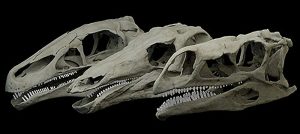
The first detailed study of a Stegosaurus skull shows that the dinosaur had a stronger bite than suspected, enabling it to eat a wider range of plants than other plant-eating dinosaurs with similarly shaped skulls.
A team of scientists from Bristol, London, Manchester and University of Birmingham compared the skull of ‘Sophie’, the Natural History Museum’s new Stegosaurus specimen, with two other dinosaurs, Plateosaurus and Erlikosaurus, which shared similar skull characteristics. Computer modelling at the University of Bristol showed that, despite looking very similar, the dinosaurs had different biting abilities.
Although the three dinosaurs existed in different time periods and locations and had very differently shaped bodies, all three had similar-looking skulls: a large low snout, feeble peg-shaped teeth, and a scissor-like jaw action only capable of moving up and down. All three ate mainly or exclusively plants.
Until now, it has been assumed that the dinosaurs probably had similar biting abilities and therefore ate similar types of plants. But the research reveals that it can be a trap to assume that because a set of dinosaurs shared a set of similar features, they all operated in the same way – function does not necessarily follow form.
As Prof. Paul Barrett, Merit Researcher at The Natural History Museum explains: ‘Our key finding really surprised us: we expected that many of these dinosaur herbivores would have skulls that worked in broadly similar ways. Instead we found that even though the skulls were fairly similar to each other in overall shape, the way they worked during biting was substantially different in each case.’
Stegosaurus lived around 150 million years ago and needed to eat a lot of plants to sustain its large size. As grasses did not exist then, it would have fed on plants such as ferns and horsetails. However the research indicates that it had a much higher bite force than anyone had suspected, enabling it to a wider range of plants than previously thought.
As Barrett, leader of the research team, comments: ‘Far from being feeble, as usually thought, Stegosaurus actually had a bite force within the range of living herbivorous mammals, such as sheep and cows.’
This wider range of plants means that scientists need to reconsider how Stegosaurus fitted into its ecological niche. For example it may have had a role in spreading the seeds of cycads – woody ever green plants that were abundant in the time of the dinosaurs and whose seeds are contained in large cones.
Dr David Button, from the University of Birmingham’s School of Geography, Earth and Environmental Sciences, said: ‘The extra information provided by computing modelling is invaluable. Although we can tell roughly what a dinosaur ate from the shape of its teeth and jaws, the differences highlighted by this study indicate that the biology and ecology of these animals is more complex than we previously thought. As we study the lives of dinosaurs in greater detail, they continue to surprise us.’
Lead author Dr Stephan Lautenschlager, a post-doctoral researcher at the University of Bristol’s School of Earth Sciences, employed digital models and computer simulations to analyse the dinosaurs’ bites, using data from 3D scans of the skulls and lower jaws. He used engineering software to give the skulls the material properties that would match as closely as possible to the real thing, for example, using data on crocodile teeth to model those of the dinosaurs. By attaching muscles to the models, he was able to examine the forces that the jaws could produce and the subsequent stresses on the skulls.
As computer power increases and software becomes more available, Lautenschlager thinks that we will see more modelling used in dinosaur research: ‘Using computer modelling techniques, we were able to reconstruct muscle and bite forces very accurately for the different dinosaurs in our study. As a result, these methods give us new and detailed insights into dinosaur biology – something that would not have been several years ago.’
Reference:
Lautenschlager, S. Brassey, C. A., Button, D. J., Barrett, P. M.. Decoupled form and function in disparate herbivorous dinosaur clades. Sci. Rep. 6, 26495; DOI: 10.1038/srep26495
Note: The above post is reprinted from materials provided by University of Birmingham.










